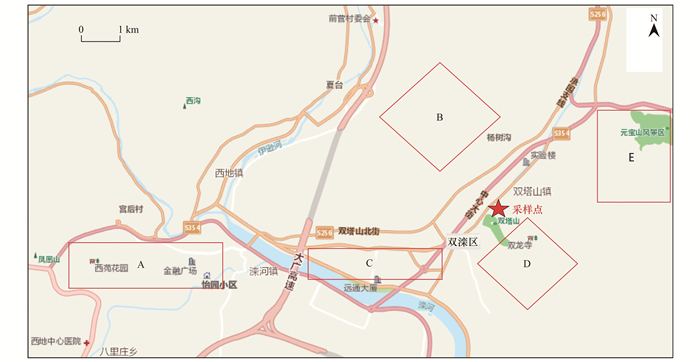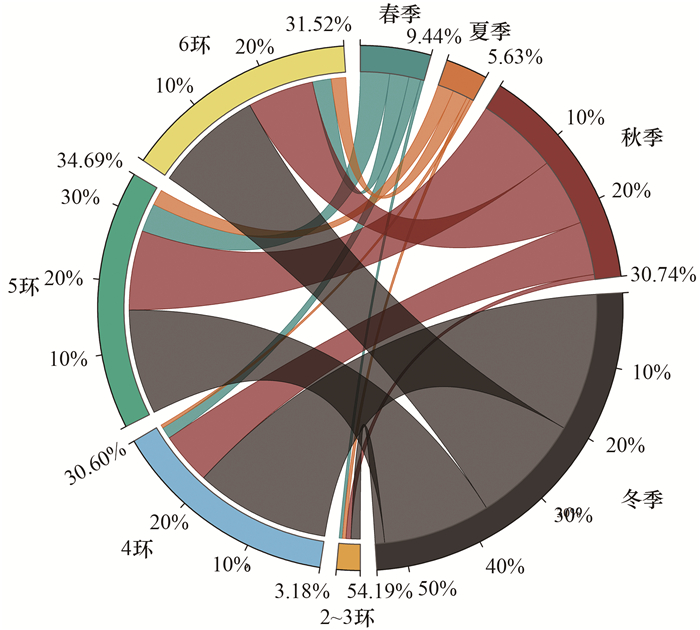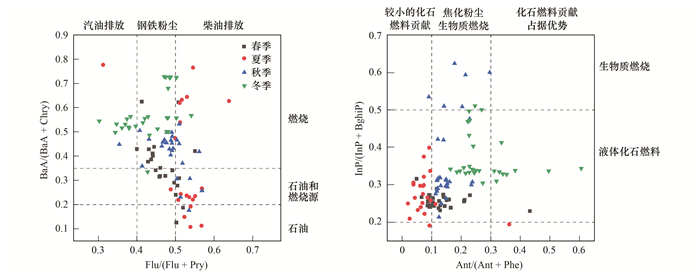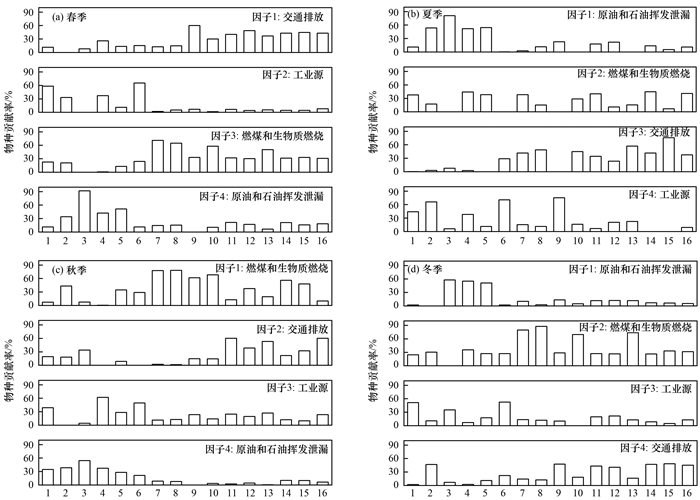2. 承德市疾病预防控制中心, 承德 067026;
3. 河北煜鸿环保科技有限公司, 石家庄 050000
2. Chengde Center for Disease Control and Prevention, Chengde 067026, China;
3. Hebei Yuhong Environmental Protection Technology Co. Ltd., Shijiazhuang 050000, China
近年来, 大气细颗粒物(PM2.5)污染引起了广泛的关注[1], 其是空气动力学直径≤2.5 μm的颗粒物, 非常容易沉积在肺部, 造成呼吸系统的损伤[2]. PM2.5还能穿过肺泡的防御屏障, 参与肺循环, 从而导致心肺损伤[3].据世界卫生组织调查报告显示, 2012年370万人死于空气污染, 其中有13%死于呼吸道感染, 16%死于肺癌, 11%死于慢性阻塞肺病[4].流行病学研究表明, 颗粒物(PM)与疾病发病率和死亡率增加有关, 特别是心肺疾病.PM已经成为中国环境空气中的首要污染物, 特别是PM2.5 [5]. Wu等[6]的研究提出PM2.5仅增加1 μg·m-3相当于COVID-19死亡增加15%.因此, 暴露于高浓度PM2.5的人群更容易感染慢性呼吸道疾病.
PM2.5中的多环芳烃(polycyclic aromatic hydrocarbons, PAHs)是一种半挥发性有机物[7], 被定义为两个或多个苯环组成的数百种有机化合物, 通过有机质的不完全燃烧释放到大气中, 主要包括化石燃料的燃烧、机动车排放、废弃物焚烧、炼油、焦炭和钢铁行业[8].由于其具有致畸、致癌和致突变的三致效应, 美国环保署将16种PAHs列入了优先控制污染物名录中, 其中的7种被定义为致癌效应较高[9].吸附在PM2.5上的PAHs持久性更强且不易被降解, 当气团远距离传输时, 在偏远地区也可以检测到[10].因此, 为有效控制PM2.5引起的大气污染, 分析PM2.5中的PAHs的季节变化、污染来源和健康风险是十分必要的.
PM2.5中的多环芳烃受到了广泛的关注, 经常吸入高浓度PAHs的PM2.5会增加患癌的风险[11], 国内外对于PAHs对人体的毒性和可能会造成的风险开展了广泛的研究[12~16].Alves等[17]的研究报道了南欧城市巴黎、伦敦和雅典中PAHs及其衍生物的季节变化, 结果表明受光化学反应的影响, 夏季的衍生物含量要高于冬季.Zheng等[18]的研究报道了上海道路扬尘中多环芳烃的毒性当量含量为2.44 μg·g-1.对北京室内PAHs的健康风险评估表明, 4个季节的终生致癌风险都超过了可接受的水平[19].Feng等[20]的研究通过对北京采暖季和非采暖季的PM2.5中PAHs进行溯源发现, 汽油、生物质燃烧、柴油、燃煤和烹饪是主要贡献者, 分别占比12.9%、17.8%、24.7%、24.3%和6.4%.华北平原是颗粒物污染最严重的地区之一[21], 也是中国多环芳烃排放密度最高的地区之一[22], 由于化石燃料和生物能源的大量使用, 京津冀地区及其周边省份在秋季和冬季仍然经常发生严重的污染事件[23], 京津冀地区仍然是中国污染最严重的地区之一[24].
承德市作为京津冀地区重要的生态涵养区和生态屏障城市, 随着城市化进程的不断加快, 能源消耗和机动车数量均有所增加, 大量污染物排放[25], 导致承德出现多次区域性的重污染灰霾天气[26].而在我国对于承德市大气PM2.5的研究较少, 且对于PM2.5结合PAHs分析研究几乎为空白.因此, 本研究的主要目的是:①分析不同季节的PM2.5和PAHs的浓度和组成特征; ②利用特征比值法和PMF模型确定PAHs的来源; ③使用ILCR模型评估由PAHs产生的健康风险.
1 材料与方法 1.1 采样点位及时间选取承德市双滦区文化中心(117.8°E, 40.96°N)为研究点位(图 1), 其西侧主要是公路和高速等交通要道, 西北方有森林覆盖区和农田耕作区; 西南方有工业集中区(承德市钢铁工业区); 采样点附近有旅游区、居民区、工业和交通要道分布, 造成该区域大气复合污染具有多样性.样品采集时间为冬季(2019年1月1~31日)、春季(2019年4月1~30日)、夏季(2019年7月1~31日)和秋季(2019年10月8日~11月8日), 使用4通道小流量采样器(采样流速为16.7 L·min-1)对PM2.5样品进行采集, 每天样品采集时长为23 h(10:00~次日09:00).

|
A:承钢工业区; B:农田及森林覆盖区; C:商业区; D:双塔山旅游区; E:元宝山旅游区 图 1 采样点分布示意 Fig. 1 Distribution of the sampling site |
使用加速溶剂萃取仪(ASE 350, Dionex, Thermo Scientific, 美国)对PM2.5中的PAHs进行提取.处理过程为:使用陶瓷剪刀将采集到的PM2.5石英膜剪碎, 放入萃取池中, 选择二氯甲烷(HPLC级, J.T Baker, 美国)作为萃取剂, 萃取压力设置为1 500 ×6.9 kPa, 萃取温度为100℃, 静态萃取5 min循环3次.萃取完成后将萃取液转移到平行蒸发浓缩仪(BUCHI Syncore, 瑞士)中, 浓缩后经过氮吹, 加入20 μL的内标物质并定容至1 mL, 转移到1.5 mL进样瓶中待测.
对于PAHs的测定, 使用气相色谱串接三重四极杆质谱(GCMS-TQ8040, SHIMADZU, 日本)进行定量分析.色谱柱类型为Rxi-5 Sil MS(30 m×0.25 mm×0.25 μm), 进样口温度为300℃, 进样方式为不分流进样, 进样量1 μL, 载气流速为40 cm·s-1, 柱温升温程序为: 起始温度60℃保持1 min, 以20℃·min-1升温至200℃保持1 min, 后继续以10℃·min-1升温至310℃, 在310℃下保持10 min.离子化方式为EI, 质谱扫描模式为多重反应监测模式(MRM), 离子源温度为230℃, 色谱-质谱接口温度为280℃, 溶剂延迟时间为4 min, 16种PAHs保留时间与定量离子和定性离子见表 1.
|
|
表 1 16种多环芳烃保留时间与定量离子和定性离子1) Table 1 Retention time and quantitative and qualitative ions of 16 types of polycyclic aromatic hydrocarbons(PAHs) |
多环芳烃的质量浓度按照以下公式计算:

|
(1) |
式中, ρ为样品的多环芳烃, μg·m-3; ρ1为样品处理后测定得到的多环芳烃的浓度, μg·L-1, ρ0为空白滤膜样品处理后测定得到的多环芳烃的浓度, μg·L-1; V为处理后样品的总体积, L; Vn为样本在标准状况下的体积, m3.
1.2.1 正定矩阵因子法正定矩阵因子法(positive matrix factorization, PMF)在颗粒物源解析方面得到了广泛的应用, 本文使用PMF 5.0(US EPA)解析16种PAHs的来源, 公式如下[27] :

|
(2) |
式中, Xij为第i个PAHs样品中j物种的浓度; gik为第i个样品中第k个污染源的贡献, fkj为第k个污染源中j物种的分数; eij为第i个样品中j物种的误差.
根据EPA的用户手册使用方法检出限(MDL)和误差分数用于计算样品的不确定度.如果浓度低于MDL, 不确定度设置为MDL的5/6, 如果浓度大于MDL, 不确定度使用以下公式进行计算.

|
(3) |
为了评估多环芳烃的致癌风险, 本研究采用了增量式终身癌症风险(ILCR)模型.这是一种基于BaP评价人体健康风险的有效评价模型.环境中的多环芳烃主要通过3种途径对人体产生危害:直接摄入、吸入和皮肤吸收, 呼吸途径是暴露于多环芳烃的关键途径[28, 29]:

|
(4) |
式中, CSF为BaP的呼吸致癌斜率因子(3.14 kg·d·mg-1); c为BaP-TEQ的浓度(ng·m-3); IR为呼吸速率(儿童和成人分别为10 m3·d-1和20 m3·d-1); t为日暴露时间(4 h); EF为年暴露频率(350 d); ED为暴露期(儿童和成人分别为6 a和53 a); BW为体重(儿童和成人分别为15 kg和70 kg); AT为平均寿命(25 550 d); cf为转换因子(10-6).
1.2.3 质量控制与质量保证每批测定样品均进行一次空白样品的分析, 所测定物质的标准曲线的相关性系数R2均大于0.995, 检出限为0.004~0.019 ng·m-3 (表 1), 空白滤膜的加标回收率为72%~107%, 相对标准偏差为0.8%~5.2%.
2 结果与讨论 2.1 PM2.5和PAHs浓度特征表 2总结了承德市4个季节PM2.5和16种多环芳烃的平均质量浓度, 图 2展示了4个季节的PM2.5和16种PAHs的总浓度(ΣPAHs)日变化趋势. ρ(PM2.5) 为9.0~121.0 μg·m-3, 4个季节的平均值为31.3 μg·m-3.
|
|
表 2 承德市不同季节的PM2.5及其PAHs浓度1) Table 2 PM2.5 and its PAHs mass concentrations in different seasons in Chengde City |

|
图 2 承德市PM2.5和ΣPAHs浓度逐日变化 Fig. 2 Daily variation of PM2.5 and ΣPAHs concentrations in Chengde City |
从单个季节来看, ρ(PM2.5)在春季为9.0~72.0 μg·m-3, 夏季为11.0~40.0 μg·m-3, 平均值分别为(26.6±15.3)μg·m-3和(23.2±8.4)μg·m-3; ρ(PM2.5)在秋季为9.0~87.0 μg·m-3, 在冬季为10.0~121.0 μg·m-3, 平均值分别为(28.7±17.1)μg·m-3和(47.7±30.4)μg·m-3.相较于我国现行的环境空气质量标准(GB 3095-2012)规定, PM2.5二级标准为75 μg·m-3, 承德市在秋冬季存在PM2.5的超标现象, 表明在秋冬季承德市存在严重的PM2.5污染天气.
图 2显示ΣPAHs与PM2.5浓度的变化趋势大致相同, 但也存在变化相反的情景.这主要是由于PM2.5中化学组分复杂种类繁多且其与ΣPAHs均受气象条件的影响较大, 气相和颗粒相分配研究模型证明了春季颗粒相中PAHs贡献会增加[30], 此外春季有利于二次气溶胶形成, 这为颗粒物吸收PAHs提供了有利的介质, 导致其在春季PM2.5浓度不高时仍会出现PAHs较高的情况.承德市4个季节的ρ(ΣPAHs)变化范围为:2.7~246.4 ng·m-3, 平均值为62.2 ng·m-3.从图 2和图 3可以发现, 4个季节中ΣPAHs和PM2.5浓度呈现出显著差异.具体而言, ρ(ΣPAHs)在春季为2.9~62.1 ng·m-3, 夏季为2.7~41.5 ng·m-3, 平均值分别为(24.7±17.4)ng·m-3和(13.7±9.4)ng·m-3; ρ(ΣPAHs)在秋季为11.2~125.6 ng·m-3, 冬季为40.7~246.4 ng·m-3.在4个季节中PM2.5和ΣPAHs的污染情况均在秋冬季污染较严重.这主要是由于气候条件的差异和不同季节的排放源造成的.在承德市春夏季风力条件较好, 降水量大, PM2.5的扩散沉降条件较好, 加上充足的光照促进了空气和颗粒物中的PAHs的降解和转化.而在秋冬季承德市气候寒冷, 相比其他地区供暖需求较高, 大量的能源消耗排放了大量的污染物, 加上逆温等不利的气候条件阻碍了污染物的扩散导致了在秋冬季出现了PM2.5和ΣPAHs浓度过高的现象.有研究表明采暖季煤炭消耗增加是导致PM2.5中PAHs大幅上升的主要原因[31], 因此为了进一步加强承德市PM2.5和PAHs的控制, 有必要加强在秋冬季各种活动中污染物的排放标准, 控制燃煤和机动车尾气中有害物质的排放.

|
所有季节总贡献率为100%, 所有环数总贡献率为100%; 线条颜色表示不同季节, 线条宽度表示占比大小 图 3 不同环数的PAHs在不同季节的贡献率 Fig. 3 Contribution of PAHs with different ring numbers in different seasons |
承德市不同季节和不同环数的PAHs分布如图 3所示.不同环数的PAHs和不同季节的PAHs占比呈现出了明显的季节变化特征.ΣPAHs在4个季节的占比分别为:54.19%(冬季)>30.74%(秋季)>9.44%(春季)>5.63%(夏季).在全年的ΣPAHs中不同环数的PAHs占比分别为:34.69%(5环)>31.52%(6环)>30.61%(4环)>3.18%(2~3环).由于其2~3环的PAHs易挥发不容易吸附在PM2.5上, 其在4个季节的质量浓度和占比均是最小的. 4环的PAHs作为半挥发性的有机物, 在气相和固定相中同时存在, 受温度影响较大[32], 在承德市的4个季节中4环的PAHs占比分别为:37.63%(冬季)>25.70%(秋季)>18.81%(春季)>8.79%(夏季), 呈现出了显著受温度影响的季节变化特征. 5环的PAHs的季节占比分别为:45.88%(春季)>42.43%(夏季)>39.26%(秋季)>29.52%(冬季). 6环的PAHs的季节占比分别为:39.37%(夏季)>32.60%(秋季)>30.26%(冬季)>30.15%(春季). 5~6环的PAHs在4个季节占到了绝对的优势, 这主要归因于5~6环的PAHs, 相对分子质量大, 沸点高难挥发, 更容易吸附在颗粒相当中[33].
在4个季节中PAHs浓度较高的主要是Chry、BbF、BaP、BghiP和InP, 而冬季PM2.5中PAHs浓度较高的是BaA、BbF、BaP和BghiP, 这些是燃煤和机动车排放的主要物质[34].有研究表明, 工业排放和车辆排放是BaP、InP和DahA等增加的主要原因[35].初步表明承德市PAHs的贡献源为机动车尾气和燃煤.
Σ7PAHs表示多环芳烃中7种致癌多环芳烃的浓度加和(BaA、Chry、BbF、BkF、BaP、InP和DahA).由表 2可知春季致癌多环芳烃的浓度平均值为(16.9±12.4)ng·m-3, 占ΣPAHs的68.41%, 夏季为(9.5±7.6)ng·m-3, 占PAHs的69.21%, 秋季致癌多环芳烃的浓度平均值为(50.4±27.2)ng·m-3, 占ΣPAHs的71.58%.冬季致癌多环芳烃的浓度平均值为(90.9±35.9)ng·m-3, 占ΣPAHs的66.45%.在秋冬季排放的Σ7PAHs浓度要远高于在春夏季.
4个季节中的ρ(BaP)平均值分别为(3.2±2.6)(春季)、(1.0±0.9)(夏季)、(9.7±5.0)(秋季)和(14.3±5.6)ng·m-3 (冬季), BaP的浓度的平均值除夏季外均超过了环境空气质量标准(GB 3095-2012), 从Σ7PAHs和BaP的浓度来看秋冬季PM2.5的致癌效应要高于春夏季.
2.2 PM2.5中PAHs源解析 2.2.1 特征比值源解析分析大多数环境样品中含有混合来源的PAHs, 特征比值法被广泛应用于解析PM2.5中PAHs的来源[36], 本研究通过利用承德市PM2.5中PAHs间的比值来揭示承德市不同季节的PAHs排放源.表 3计算了Flu/(Flu+Pyr)、BaA/(BaA+Chry)、Ant/(Ant+Phe)和InP/(InP+BghiP)的比值.
|
|
表 3 承德市不同季节的PM2.5中PAHs特征比值 Table 3 Diagnostic ratios of PAHs in PM2.5 in different seasons in Chengde City |
Flu/(Flu+Pyr)的比值可以区分汽油和柴油排放源[36], 当Flu/(Flu+Pyr)小于0.5是汽油排放源的特征, 大于0.5是柴油排放源的特征.从图 4可以看出, 春季、秋季和冬季的Flu/(Flu+Pyr)大多数分布在小于0.5的范围内, 同时在表 3中平均值均小于0.5, 表明在这3个季节汽油排放要显著高于柴油.而在夏季Flu/(Flu+Pyr)多数大于0.5, 说明在夏季柴油排放贡献较为显著, 柴油相较于汽油不易挥发, 在夏季温度较高柴油排放的PAHs更容易挥发吸附到PM2.5中, 温度较低时会发生沉降, 污染土壤.

|
图 4 承德市不同季节的PM2.5中PAHs特征比值 Fig. 4 Graphical representation of the diagnostic ratios of PAHs in PM2.5 in different seasons in Chengde City |
有研究表明炼钢粉尘排放源附近的Flu/(Flu+Pyr)为0.40左右[37], 4个季节的Flu/(Flu+Pyr)平均值也接近这个值, 说明在采样点附近存在炼钢粉尘排放.有研究表明[38, 39], BaA/(BaA+Chry)小于0.2时主要为石油来源, 介于0.2~0.35之间是石油和燃烧混合排放的特征, 大于0.35则表明主要来源于燃烧源.承德市4个季节的BaA/(BaA+Chry)平均值均大于0.35, 说明在4个季节均呈现出了机动车尾气主导的排放源.Ant/(Ant+Phe)可以用来评估PAHs中化石燃料的贡献大小[39], 小于0.1证明化石燃料贡献较小, 大于0.1则说明化石燃料燃烧来源占据优势, 有研究表明Ant/(Ant+Phe)介于0.1~0.3之间代表焦化粉尘和生物质燃烧混合源[37].从表 3和图 4可知, 承德市4个季节均存在不同程度的化石燃料燃烧和生物质燃烧排放, 在春季、秋季和冬季受到了焦化粉尘和生物质燃烧的影响, 其中秋季和冬季较为显著.除夏季外其余3个季节的Ant/(Ant+Phe)平均值均大于0.1, 说明在春季、秋季和冬季化石燃料贡献相比于夏季更显著.InP/(Inp+BghiP)在0.2~0.5之间代表液体化石燃料燃烧来源, 当这个值大于0.5的时候则表示生物质燃烧[40].由图 4可知4个季节的InP/(InP+BghiP)大多数介于0.2~0.5之间, 表明4个季节都存在显著的化石燃料燃烧的排放情况, 秋季的InP/(InP+BghiP)在大于0.5的范围分布数量相对较多, 表明在秋季受到的生物质燃烧的贡献相比其他季节更显著.
比值法分析结果表明, 承德市4个季节PAHs排放源有所差异, 生物质燃烧、化石燃料燃烧、机动车排放、燃煤和炼钢烟尘是承德市PM2.5中PAHs的主要来源.
2.2.2 PMF源解析分析为了有效地控制承德市大气污染, 有必要对其潜在污染源进行分析.PMF是一种广泛应用于潜在PAHs的来源识别的方法, 可以在没有污染来源特征的情况下对污染物进行来源识别[41].PMF算法是由Paatero等[42, 43]开发的一种加权的最小二乘法.与传统的因子分析方法相比, PMF具有非负约束的优势, 并且能够将每个数据的不确定性视为该点的权重.本文使用US EPA PMF5.0 Model, 用于确定承德市PM2.5中16种PAHs的主要来源并揭示不同源类贡献率的大小.分别输入春季(28组)、夏季(30组)、秋季(30组)和冬季(29组)的环境样本以及16种PAHs的不确定度, 基础模型运行20次.
信噪比(S/N)适用于表示测得数据是真实的还是在数据噪声范围内[42].使用信噪比数值大小对物种进行分类, S/N>2被定义为:“Strong”, 0.2<S/N<2被定义为:“Weak”, S/N<0.2被定义为:“Bad”. 16种测得的PAHs均被定义为“Strong”.综合考虑选择提取4个因子, 最小值Q值接近理论值Qrobust, 16种PAHs的估算浓度和实测浓度之间的相关性系数均大于0.7, 表明实测的浓度可以用选择的4个因子来解释.
如图 5所示, 分析结果表明承德市4个季节的16种PAHs可以识别出4种不同的来源, 且每个季节的排放来源贡献率有着不同的差异.以春季为例, 因子1中BaA、BbF、BkF、InP、DahA和BghiP贡献率较高, DahA、BghiP和InP高环数的PAHs是汽车尾气排放的标志物[44], 此外BbF和BkF是柴油车排放的示踪物[45], BaA来源于以天然气, 但是公交车和出租车以天然气为燃料排放含多环芳烃的尾气[16].因此因子1被认定为交通排放.因子2的主要贡献物种为NaP、Flu、Ace和Ant, Flu是工业锅炉和热电厂的标志物[46], Acy被用作水泥行业的指示剂[47], Nap也被报道为在钢铁行业中的优势物种[48], Ant被确定为焦化工业焦炉排放的指示物[49], 因此, 因子2被确定为工业排放.因子3中Flt、Pyr、Chry和BaP的贡献率较高, Flt、Pyr和BaP是燃煤排放的产物[50], Chry是天然气燃烧的标志物, 也在农业焚烧木炭燃烧和垃圾焚烧中产生[16], 因此因子3被确定为燃煤和生物质燃烧来源.因子4中Ace、Phe、Flu和Acy的贡献率比较高, Acy、Ace、Phe和Flu是原油和石油产品泄漏和挥发的标志产物[51].其中Acy和Ace对漏油和泄漏的贡献很大[52]因子4代表了原油和石油挥发泄漏.针对不同季节不同的因子被认定为不同的来源.

|
1.Nap, 2.Acy, 3.Ace, 4.Flu, 5.Phe, 6.Ant, 7.Fla, 8.Pyr, 9.BaA, 10.Chry, 11.BbF, 12.BkF, 13.BaP, 14.InP, 15.DahA, 16.BghiP 图 5 PMF模型中各因子中不同物种在不同季节的贡献率 Fig. 5 Contributions of different species in the PMF model for each factor in different seasons |
由图 6可知, 春季受到燃煤和生物质燃烧(32.19%)及交通排放(28.06)的贡献率较高, 其次是原油和石油的挥发泄漏(23.91%), 工业源(15.84%)最少, 夏季则是交通排放(27.99%)、工业源(25.85%)、燃煤和生物质燃烧(23.73%)以及原油和石油的挥发泄漏(22.43%), 4个排放源的贡献差异不大, 这可能与夏季温度高光照强度大, PAHs的二次反应和降解有关.秋季贡献率较高的有燃煤和生物质燃烧(37.28%)、交通排放(23.93%)和工业源(22.75%), 原油和石油会发泄露(16.03%)贡献率较少.冬季解析出的贡献率特征和秋季相似, 依次为燃煤和生物质燃烧(39.34%)、交通排放(26.57%)、工业源(18.19%)以及原油和石油挥发泄漏(15.9%).由于春夏季温度较高, 原油和石油挥发泄漏贡献要高于秋冬季, 燃煤和生物质燃烧贡献率呈现出冬季>秋季>春季>夏季的季节变化特征, 在河北地区秋季的10月为收割季节, 农作残渣通常作为燃料, 该季节生物质燃烧贡献率较高.而冬季由于供暖的需求, 燃煤和生物质燃烧取暖造成的冬季燃煤和生物质燃烧贡献要高于其他季节.

|
图 6 不同季节的PMF模型解析结果 Fig. 6 Results of PMF model analysis for different seasons |
PAHs具有致癌毒性, 与PM2.5相结合的PAHs能够通过呼吸进入人体, 对人体产生不利影响[53].EPA筛选出的16种优先控制的PAHs分别有着不同程度的毒性, 其中以BaP的致癌毒性最强, 所以计算每个单体的BaP当量浓度(BaP equivalent concentration, BaPeq), 并利用BaPeq计算了BaP的总和毒性当量浓度(BaP toxicity equivalent concentration, BaPTEQ)[54].根据US EPA的健康风险评估模型, 以成人和儿童作为研究对象, 计算了承德市不同季节的PAHs经过呼吸暴露产生的致癌风险.承德市四季ρ(BaP)平均值呈现为:(14.3±5.6)ng·m-3 (冬季)>(9.7±5.0)ng·m-3 (秋季)>(3.2±2.6)ng·m-3 (春季)>(1.0±0.7)ng·m-3 (夏季), 除夏季外其浓度均超过了我国现行空气质量标准的限值(2.5 ng·m-3), 初步表明在春季、秋季和冬季存在着不同程度的潜在致癌风险.
图 7显示BaPTEQ也呈现出相同的规律:(31.6±12.9)ng·m-3 (冬季)>(17.1±8.6)ng·m-3 (秋季)>(5.3±3.9)ng·m-3 (春季)>(2.2±1.5)ng·m-3 (夏季).BaP和BaPTEQ值均表现为秋冬季较高, 春夏季较低.且承德市BaPTEQ全年的变化范围为0.2~58.5 ng·m-3, 平均值为14.1 ng·m-3, 高于南京(3.14 ng·m-3)[55]和广州(6.69 ng·m-3)[51]等我国南方城市; 相较于北京(58.93 ng·m-3)[56]、西安(55.4 ng·m-3)[57]和合肥(34.5 ng·m-3)[58]等城市要低.有研究表明[59], 采暖季供暖导致环境中PAHs毒性当量浓度增加, 在北方采暖季由PAHs产生的致癌风险会升高.

|
图 7 承德市不同季节的毒性当量浓度和呼吸暴露途径估算的ILCR值 Fig. 7 Toxic equivalent concentrations and ILCR values estimated by respiratory exposure pathways during the different seasons in Chengde City |
美国EPA将致癌风险划分为:可接受风险水平(ILCR<10-6)、潜在致癌风险(10-6<ILCR<10-4)和较高的致癌风险(10-4<ILCR)[60].经计算得到承德市不同季节的PAHs通过呼吸暴露途径产生的ILCR值如图 7所示.成人由于其体重较大、暴露时间较长、其所面临的致癌风险约为儿童的4~5倍.承德市不同季节的成人和儿童的ILCR分布均呈现出:冬季>秋季>春季>夏季.
承德市春季成人和儿童ILCR范围分别为3.41×10-7 ~1.5×10-6和9.16×10-9 ~4.04×10-7, 对于成人在春季采样时间内存在高出可接受风险水平的情况, 存在一定的潜在致癌风险; 儿童在春季处于可接受的健康风险水平(ILCR<10-6).在夏季PAHs对于成人和儿童在呼吸暴露途径产生健康风险处于可接受健康风险水平; 在秋季(成人ILCR:1.83×10-6)和冬季(成人ILCR:3.36×10-6)PAHs对成人存在潜在的致癌风险, 且冬季成人的ILCR值约为秋季的2倍、春季的6倍、夏季的16倍; 儿童在秋季和冬季ILCR变化范围分别为6.59×10-8 ~8.92×10-7和2.43×10-7 ~1.68×10-6, 表明了承德市冬季PAHs对儿童存在一定的潜在致癌风险.以上结果表明承德市在秋冬季节的潜在致癌风险要高于夏季和春季, 这是由于秋冬季节不利的气象条件叠加污染物排放造成的.因此, 居民在外出时, 尤其是秋冬季节, 应当采取防护措施, 减少与空气中污染物的接触.
通过结合不同排放源贡献, 以成人为例计算了不同季节的4种排放源产生的ILCR(图 8).在春季由燃煤和生物质燃烧(1.82×10-7)产生的ILCR值最高, 其次是交通排放(1.59×10-7)、原油和石油挥发泄漏(1.35×10-7)以及工业源(8.97×10-8); 在夏季4种排放源产生的ILCR值相差不大, 依次为交通排放(5.92×10-8)、工业源(5.47×10-8)、燃煤和生物质燃烧(5.02×10-8)以及原油和石油挥发泄漏(4.72×10-8); 在秋季由燃煤和生物质燃烧(6.8×10-7)产生的ILCR值最高, 其他3种相差不大, 依次为交通排放(4.37×10-7)、工业源(4.15×10-7)以及原油和石油挥发泄漏(2.93×10-7); 冬季与秋季相似, 由燃煤和生物质燃烧(1.32×10-6)产生的ILCR值最高, 交通排放(8.93×10-7)次之, 工业源(6.11×10-7)以及原油和石油挥发泄漏(5.34×10-7)相差不大.在春季、秋季和冬季, 由燃煤和生物质燃烧、交通排放产生的ILCR值较高, 政府也应当采取一些措施来减少燃烧源和交通排放产生的PAHs浓度水平, 降低风险.

|
图 8 承德市不同季节的4种不同来源的导致的健康风险 Fig. 8 Health risks caused by four different sources in different seasons in Chengde City |
(1) 在采样期间, 承德市ρ(PM2.5)和ρ(ΣPAHs)分别为9.0~121.0 μg·m-3和2.7~246.4 ng·m-3, 随着季节的变化, PM2.5的升高伴随着ΣPAHs的增加. ρ(ΣPAHs)的季节平均值表现为:(136.8±52.1)ng·m-3 (冬季)>(70.3±36.7)ng·m-3 (秋季)>(24.7±17.4)ng·m-3 (春季)>(13.7±9.4)ng·m-3 (夏季).
(2) 在全年的ΣPAHs中不同环数的PAHs占比分别为:34.69%(5环)>31.52%(6环)>30.61%(4环)>3.18%(2~3环). 2~3环是易挥发的PAHs, 在4个季节中分布较少, 4~6环的PAHs占绝对的优势; 4个季节中Chry、BbF、BaP、BghiP和InP这5种单体PAHs浓度较高, 初步体现出了机动车尾气和燃煤排放的影响.
(3) 特征比值法分析结果表明, 承德市4个季节PAHs排放源有所差异, 生物质燃烧、化石燃料燃烧、机动车排放、燃煤和炼钢烟尘是承德市PM2.5中PAHs的主要来源; 通过使用PMF分析得出承德市不季节的排放源贡献率是不同的, 其中春夏季由于温度较高产生的原油和石油挥发泄漏贡献率较高, 而秋冬季燃煤和生物质燃烧的贡献率增加明显.
(4) 承德市增量终生致癌风险(ILCR)结果表明, 成人在春季、秋季和冬季存在不同程度的潜在致癌风险, 儿童仅在冬季存在潜在的致癌风险, 且在采样期间成人和儿童ILCR在4个季节的变化均为冬季>秋季>春季>夏季; 基于源解析的致癌风险分配计算表明, 在春季、秋季和冬季, 由燃煤和生物质燃烧、交通排放产生的ILCR值较高.
| [1] |
贺博文, 聂赛赛, 王帅, 等. 承德市PM2.5中碳质组分的季节分布特征及来源解析[J]. 环境科学, 2021, 42(11): 5152-5161. He B W, Nie S S, Wang S, et al. Seasonal variation and source apportionment of carbonaceous species in PM2.5 in Chengde[J]. Environmental Science, 2021, 42(11): 5152-5161. |
| [2] |
杜沛, 王建州. 北京市控制PM2.5污染的健康效益评估[J]. 环境科学, 2021, 42(3): 1255-1267. Du P, Wang J Z. Health benefit assessment of PM2.5 pollution control in Beijing[J]. Environmental Science, 2021, 42(3): 1255-1267. DOI:10.3969/j.issn.1000-6923.2021.03.029 |
| [3] | Qi ZH, Song YY, Ding QQ, et al. Water soluble and insoluble components of PM2.5 and their functional cardiotoxicities on neonatal rat cardiomyocytes in vitro[J]. Ecotoxicology and Environmental Safety, 2019, 168: 378-387. DOI:10.1016/j.ecoenv.2018.10.107 |
| [4] | Lee B J, Kim B, Lee K. Air pollution exposure and cardiovascular disease[J]. Toxicological Research, 2014, 30(2): 71-75. DOI:10.5487/TR.2014.30.2.071 |
| [5] |
王娟, 郭观林, 秦宁, 等. 某工业城市大气颗粒物中PAHs的粒径分布及人体呼吸系统暴露评估[J]. 环境科学, 2019, 40(10): 4345-4354. Wang J, Guo G L, Qin N, et al. Size distribution characteristics and inhalation exposure of particle-bound PAHs in an industrial city[J]. Environmental Science, 2019, 40(10): 4345-4354. |
| [6] | Wu X, Nethery R C, Sabath B M, et al. Exposure to air pollution and COVID-19 mortality in the United States: a nationwide cross-sectional study[J]. MedRxiv. DOI:10.1101/2020.04.05.20054502 |
| [7] |
赵孝囡, 王申博, 杨洁茹, 等. 郑州市PM2.5组分、来源及其演变特征[J]. 环境科学, 2021, 42(8): 3633-3643. Zhao X N, Wang S B, Yang J R, et al. Chemical components and sources of PM2.5 and their evolutive characteristics in Zhengzhou[J]. Environmental Science, 2021, 42(8): 3633-3643. |
| [8] |
董喆, 姜楠, 王佳, 等. 郑州市大气PM2.5中多环芳烃的污染特征及健康风险评价[J]. 郑州大学学报(理学版), 2020, 52(2): 108-113. Dong Z, Jiang N, Wang J, et al. Pollution characterization and health risk assessment of PM2.5-bound PAHs in ambient air in Zhengzhou[J]. Journal of Zhengzhou University (Natural Science Edition), 2020, 52(2): 108-113. |
| [9] |
吴志远, 张丽娜, 夏天翔, 等. 基于土壤重金属及PAHs来源的人体健康风险定量评价: 以北京某工业污染场地为例[J]. 环境科学, 2020, 41(9): 4180-4196. Wu Z Y, Zhang L N, Xia T X, et al. Quantitative assessment of human health risks based on soil heavy metals and PAHs sources: take a polluted industrial site of Beijing as an example[J]. Environmental Science, 2020, 41(9): 4180-4196. |
| [10] | Chen Y, Luo X S, Zhao Z, et al. Summer-winter differences of PM2.5 toxicity to human alveolar epithelial cells (A549) and the roles of transition metals[J]. Ecotoxicology and Environmental Safety, 2018, 165: 505-509. |
| [11] |
齐静文, 张瑞芹, 姜楠, 等. 洛阳市秋冬季PM2.5中多环芳烃的污染特征、来源解析及健康风险评价[J]. 环境科学, 2021, 42(2): 595-603. Qi J W, Zhang R Q, Jiang N, et al. Characterization, sources, and health risks of PM2.5-bound PAHs during autumn and winter in Luoyang City[J]. Environmental Science, 2021, 42(2): 595-603. |
| [12] | Niu X Y, Ho S S H, Ho K F, et al. Atmospheric levels and cytotoxicity of polycyclic aromatic hydrocarbons and oxygenated-PAHs in PM2.5 in the Beijing-Tianjin-Hebei region[J]. Environmental Pollution, 2017, 231: 1075-1084. |
| [13] | Mehmood T, Zhu T L, Ahmad I, et al. Ambient PM2.5 and PM10 bound PAHs in Islamabad, Pakistan: concentration, source and health risk assessment[J]. Chemosphere, 2020, 257. DOI:10.1016/j.chemosphere.2020.127187 |
| [14] | Gong X S, Shen Z X, Zhang Q, et al. Characterization of polycyclic aromatic hydrocarbon (PAHs) source profiles in urban PM2.5 fugitive dust: A large-scale study for 20 Chinese cites[J]. Science of the Total Environment, 2019, 687: 188-197. |
| [15] | Kang M, Kim K, Choi N, et al. Recent occurrence of PAHs and n-Alkanes in PM2.5 in Seoul, Korea and characteristics of their sources and toxicity[J]. International Journal of Environmental Research and Public Health, 2020, 17(4). DOI:10.3390/ijerph17041397 |
| [16] | Azimi-Yancheshmeh R, Moeinaddini M, Feiznia S, et al. Seasonal and spatial variations in atmospheric PM2.5-bound PAHs in Karaj City, Iran: sources, distributions, and health risks[J]. Sustainable Cities and Society, 2021, 72. DOI:10.1016/j.scs.2021.103020 |
| [17] | Alves C A, Vicente A M, Custódio D, et al. Polycyclic aromatic hydrocarbons and their derivatives (nitro-PAHs, oxygenated PAHs, and azaarenes) in PM2.5 from Southern European cities[J]. Science of the Total Environment, 2017, 595: 494-504. |
| [18] | Zheng X, Yang Y, Liu M, et al. PAH determination based on a rapid and novel gas purge-microsyringe extraction (GP-MSE) technique in road dust of Shanghai, China: characterization, source apportionment, and health risk assessment[J]. Science of the Total Environment, 2016, 557-558: 688-696. |
| [19] | Chen Y, Li X H, Zhu T L, et al. PM2.5-bound PAHs in three indoor and one outdoor air in Beijing: Concentration, source and health risk assessment[J]. Science of the Total Environment, 2017, 586: 255-264. |
| [20] | Feng B H, Li L J, Xu H B, et al. PM2.5-bound polycyclic aromatic hydrocarbons (PAHs) in Beijing: Seasonal variations, sources, and risk assessment[J]. Journal of Environmental Sciences, 2019, 77: 11-19. |
| [21] |
张逸琴, 王杰, 高健, 等. 2016~2017年采暖期华北平原东部PM2.5组分特征及来源解析[J]. 环境科学, 2019, 40(12): 5202-5212. Zhang Y Q, Wang J, Gao J, et al. Chemical composition characteristics and source apportionment of PM2.5 during the heating period of 2016-2017 in the eastern part of the north China plain[J]. Environmental Science, 2019, 40(12): 5202-5212. |
| [22] | Zhang Y J, Lin Y, Cai J, et al. Atmospheric PAHs in North China: spatial distribution and sources[J]. Science of the Total Environment, 2016, 565: 994-1000. |
| [23] |
王彤, 华阳, 许庆成, 等. 京津冀郊区站点秋冬季大气PM2.5来源解析[J]. 环境科学, 2019, 40(3): 1035-1042. Wang T, Hua Y, Xu Q C, et al. Source apportionment of PM2.5 in suburban area of Beijing-Tianjin-Hebei region in autumn and winter[J]. Environmental Science, 2019, 40(3): 1035-1042. |
| [24] |
朱媛媛, 高愈霄, 柴文轩, 等. 京津冀及周边区域PM2.5叠加沙尘重污染过程特征及预报效果分析[J]. 环境科学, 2020, 41(2): 574-586. Zhu Y Y, Gao Y X, Chai W X, et al. Heavy pollution characteristics and assessment of PM2.5 predicted model results in Beijing-Tianjin-Hebei region and surrounding areas during November 22 to December 4, 2018[J]. Environmental Science, 2020, 41(2): 574-586. |
| [25] |
尹晓梅, 乔林, 朱晓婉, 等. 北京地区偏南风和偏东风条件下污染特征差异[J]. 环境科学, 2020, 41(11): 4844-4854. Yin X M, Qiao L, Zhu X W, et al. Differences in pollution characteristics under the southerly and easterly wind in Beijing[J]. Environmental Science, 2020, 41(11): 4844-4854. |
| [26] |
周胜, 陈桐生, 黄报远, 等. 2015和2018年承德市区PM2.5排放与来源对比分析[J]. 环境工程, 2019, 37(11): 125-131. Zhou S, Chen T S, Huang B Y, et al. Comparison analysis of emissions and sources of PM2.5 in the urban area in Chengde in 2015 and 2018[J]. Environmental Engineering, 2019, 37(11): 125-131. |
| [27] |
王帅, 崔建升, 冯亚平, 等. 石家庄市挥发性有机物和臭氧的污染特征及源解析[J]. 环境科学, 2020, 41(12): 5325-5335. Wang S, Cui J S, Feng Y P, et al. Characteristics and source apportionment of VOCs and O3 in Shijiazhuang[J]. Environmental Science, 2020, 41(12): 5325-5335. |
| [28] | Zhang Y X, Tao S, Shen H Z, et al. Inhalation exposure to ambient polycyclic aromatic hydrocarbons and lung cancer risk of Chinese population[J]. Proceedings of the National Academy of Sciences of the United States of America, 2009, 106(50): 21063-21067. |
| [29] | Shen H Z, Tao S, Liu J F, et al. Global lung cancer risk from PAH exposure highly depends on emission sources and individual susceptibility[J]. Scientific Reports, 2014, 4. DOI:10.1038/srep06561 |
| [30] | Nguyen T N T, Jung K S, Son J M, et al. Seasonal variation, phase distribution, and source identification of atmospheric polycyclic aromatic hydrocarbons at a semi-rural site in Ulsan, South Korea[J]. Environmental Pollution, 2018, 236: 529-539. |
| [31] |
顾爱军, 刘佳澍, 罗世鹏, 等. 常州市大气PM2.5中PAHs污染特征及来源解析[J]. 环境科学, 2017, 38(8): 3110-3119. Gu A J, Liu J S, Luo S P, et al. Pollution characteristics and source identification of PAHs in atmospheric PM2.5 in Changzhou City[J]. Environmental Science, 2017, 38(8): 3110-3119. |
| [32] |
张艺璇, 曹芳, 郑涵, 等. 2017年秋季长春市PM2.5中多环芳烃的污染来源及健康风险评价[J]. 环境科学, 2020, 41(2): 564-573. Zhang Y X, Cao F, Zheng H, et al. Source apportionment and health risk assessment of polycyclic aromatic hydrocarbons in PM2.5 in Changchun City, autumn of 2017[J]. Environmental Science, 2020, 41(2): 564-573. |
| [33] | Li X X, Kong S F, Yin Y, et al. Polycyclic aromatic hydrocarbons (PAHs) in atmospheric PM2.5 around 2013 Asian Youth Games period in Nanjing[J]. Atmospheric Research, 2016, 174-175: 85-96. |
| [34] |
马社霞, 张啸, 陈来国, 等. 海南五指山背景点PM2.5中多环芳烃的污染特征[J]. 中国环境科学, 2013, 33(S1): 103-107. Ma S X, Zhang X, Chen L G, et al. Characteristics of PAHs concentration in the atmospheric PM2.5 in Wuzhi Mountain background in Hainan, South China[J]. China Environmental Science, 2013, 33(S1): 103-107. |
| [35] | Bourotte C, Forti M C, Taniguchi S, et al. A wintertime study of PAHs in fine and coarse aerosols in São Paulo city, Brazil[J]. Atmospheric Environment, 2005, 39(21): 3799-3811. |
| [36] | Bragato M, Joshi K, Carlson J B, et al. Combustion of coal, bagasse and blends thereof: Part Ⅱ: speciation of PAH emissions[J]. Fuel, 2012, 96: 51-58. |
| [37] | Wang S B, Ji Y Q, Zhao J B, et al. Source apportionment and toxicity assessment of PM2.5-bound PAHs in a typical iron-steel industry city in northeast China by PMF-ILCR[J]. Science of the Total Environment, 2020, 713. DOI:10.1016/j.scitotenv.2019.136428 |
| [38] | Ravindra K, Sokhi R, Van Grieken R. Atmospheric polycyclic aromatic hydrocarbons: source attribution, emission factors and regulation[J]. Atmospheric Environment, 2008, 42(13): 2895-2921. |
| [39] | Yunker M B, Macdonald R W, Vingarzan R, et al. PAHs in the Fraser River basin: a critical appraisal of PAH ratios as indicators of PAH source and composition[J]. Organic Geochemistry, 2002, 33(4): 489-515. |
| [40] | Mancilla Y, Mendoza A, Fraser M P, et al. Organic composition and source apportionment of fine aerosol at Monterrey, Mexico, based on organic markers[J]. Atmospheric Chemistry and Physics, 2016, 16(2): 953-970. |
| [41] | Gao B, Wang X M, Zhao X Y, et al. Source apportionment of atmospheric PAHs and their toxicity using PMF: impact of gas/particle partitioning[J]. Atmospheric Environment, 2015, 103: 114-120. |
| [42] | Paatero P, Tapper U. Analysis of different modes of factor analysis as least squares fit problems[J]. Chemometrics and Intelligent Laboratory Systems, 1993, 18(2): 183-194. |
| [43] | Paatero P, Tapper U. Positive matrix factorization: a non-negative factor model with optimal utilization of error estimates of data values[J]. Environmetrics, 1994, 5(2): 111-126. |
| [44] | Li Q, Jiang N, Yu X, et al. Sources and spatial distribution of PM2.5-bound polycyclic aromatic hydrocarbons in Zhengzhou in 2016[J]. Atmospheric Research, 2019, 216: 65-75. |
| [45] | Wang X T, Miao Y, Zhang Y, et al. Polycyclic aromatic hydrocarbons (PAHs) in urban soils of the megacity Shanghai: occurrence, source apportionment and potential human health risk[J]. Science of the Total Environment, 2013, 447: 80-89. |
| [46] | Cvetković A, Jovašević-Stojanović M, Marković D, et al. Concentration and source identification of polycyclic aromatic hydrocarbons in the metropolitan area of Belgrade, Serbia[J]. Atmospheric Environment, 2015, 112: 335-343. |
| [47] | Yang H H, Lee W J, Chen S J, et al. PAH emission from various industrial stacks[J]. Journal of Hazardous Materials, 1998, 60(2): 159-174. |
| [48] | Dat N D, Chang M B. Review on characteristics of PAHs in atmosphere, anthropogenic sources and control technologies[J]. Science of the Total Environment, 2017, 609: 682-693. |
| [49] | Aydin Y M, Kara M, Dumanoglu Y, et al. Source apportionment of polycyclic aromatic hydrocarbons (PAHs) and polychlorinated biphenyls (PCBs) in ambient air of an industrial region in Turkey[J]. Atmospheric Environment, 2014, 97: 271-285. |
| [50] | Callén M S, Iturmendi A, López J M. Source apportionment of atmospheric PM2.5-bound polycyclic aromatic hydrocarbons by a PMF receptor model. Assessment of potential risk for human health[J]. Environmental Pollution, 2014, 195: 167-177. |
| [51] | Liu J J, Man R L, Ma S X, et al. Atmospheric levels and health risk of polycyclic aromatic hydrocarbons (PAHs) bound to PM2.5 in Guangzhou, China[J]. Marine Pollution Bulletin, 2015, 100(1): 134-143. |
| [52] | Liu Y K, Yu Y P, Liu M, et al. Characterization and source identification of PM2.5-bound polycyclic aromatic hydrocarbons (PAHs) in different seasons from Shanghai, China[J]. Science of the Total Environment, 2018, 644: 725-735. |
| [53] | Menzie C A, Potocki B B, Santodonato J. Exposure to carcinogenic PAHs in the environment[J]. Environmental Science & Technology, 1992, 26(7): 1278-1284. |
| [54] | Slezakova K, Castro D, Delerue-Matos C, et al. Impact of vehicular traffic emissions on particulate-bound PAHs: levels and associated health risks[J]. Atmospheric Research, 2013, 127: 141-147. |
| [55] | Liu X S, Schnelle-Kreis J, Schloter-Hai B, et al. Analysis of PAHs associated with PM10 and PM2.5 from different districts in Nanjing[J]. Aerosol and Air Quality Research, 2019, 19(10): 2294-2307. |
| [56] | Wang X P, Zong Z, Tian C G, et al. Assessing on toxic potency of PM2.5-bound polycyclic aromatic hydrocarbons at a national atmospheric background site in North China[J]. Science of the Total Environment, 2018, 612: 330-338. |
| [57] | Li J J, Wang G H, Aggarwal S G, et al. Comparison of abundances, compositions and sources of elements, inorganic ions and organic compounds in atmospheric aerosols from Xi'an and New Delhi, two megacities in China and India[J]. Science of the Total Environment, 2014, 476-477: 485-495. |
| [58] | Hu R Y, Liu G J, Zhang H, et al. Particle-associated polycyclic aromatic hydrocarbons (PAHs) in the atmosphere of Hefei, China: levels, characterizations and health risks[J]. Archives of Environmental Contamination and Toxicology, 2018, 74(3): 442-451. |
| [59] | Kong S, Ding X, Bai Z, et al. A seasonal study of polycyclic aromatic hydrocarbons in PM2.5 and PM2.5-10 in five typical cities of Liaoning Province, China[J]. Journal of Hazardous Materials, 2010, 183(1-3): 70-80. |
| [60] | Zhang Y, Zheng H, Zhang L, et al. Fine particle-bound polycyclic aromatic hydrocarbons (PAHs) at an urban site of Wuhan, central China: characteristics, potential sources and cancer risks apportionment[J]. Environmental Pollution, 2019, 246: 319-327. |
 2022, Vol. 43
2022, Vol. 43


